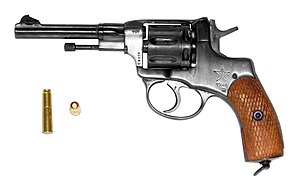M1895 Nagant
| Nagant M1895 revolver | |
|---|---|

A Nagant M1895 produced in 1941 by the Tula Arsenal with its 7.62×38mmR ammunition
|
|
| Type | Revolver |
| Place of origin | Belgium (made for the Russian Empire) |
| Service history | |
| In service | 1895–present |
| Used by | See Users |
| Wars |
Boxer Rebellion Russo-Japanese War World War I Russian Revolution of 1917 Russian Civil War Spanish Civil War Winter War World War II Chinese Civil War Hukbalahap Rebellion Korean War Vietnam War |
| Production history | |
| Designer | Emile & Léon Nagant |
| Designed | 1886 |
| Manufacturer | Nagant, Soviet Arsenals (Tula & Izhevsk), Państwowa Fabryka Karabinów |
| Produced | 1895–1945 (1895–1898 Nagant, 1899–1945 Tula, 1930 Warsaw, 1943–1945 Izhevsk) |
| No. built | ~2,000,000 |
| Variants | Single-action NCO version, .22 caliber sporting model |
| Specifications | |
| Weight | 1.8 lb (0.8 kg), unloaded |
| Length | 10.5 in (235 mm) |
| Barrel length | 4.5 in (114 mm) |
|
|
|
| Cartridge | 7.62×38mmR 7.62mm Nagant |
| Caliber | 7.62mm |
| Action | Double action, Single-action |
| Rate of fire | 14–21 rounds/min |
| Muzzle velocity | 891 ft/s (272 m/s) |
| Effective firing range | 50 yds (46 m) |
| Feed system | 7-round cylinder |
| Sights | Fixed front post and rear notch |
The Nagant M1895 Revolver was a seven-shot, gas-seal revolver designed and produced by Belgian industrialist Léon Nagant for the Russian Empire.
The Nagant M1895 was chambered for a proprietary cartridge, 7.62×38mmR, and featured an unusual "gas-seal" system, in which the cylinder moved forward when the gun was cocked, to close the gap between the cylinder and the barrel, providing a boost to the muzzle velocity of the fired projectile and allowing the weapon to be suppressed (an unusual ability for a revolver).
Léon Nagant and his brother Émile were well known in the Russian Tsar's court and military administration because of the part they had played in the design of the Russian service rifle, the Mosin–Nagant Model 1891. The Nagant M1895 was adopted as the standard issue side arm for the Imperial Russian Army and police officers, where it replaced earlier Smith & Wesson models.
Production began in Liège, Belgium; however Russia purchased the manufacturing rights in 1898, and moved production to the Tula Arsenal in Russia, and was soon producing 20,000 examples per year.
Until 1918 it was produced in two versions: a double-action version for officers, and a cheaper single-action version for the ranks. It continued to be used after the Russian Revolution by the Red Army and Soviet security forces. The distinctive shape and name helped it achieve cult status in Russia and in the early 1930s the presentation of a Nagant M1895 revolver with an embossed Red Star was one of the greatest honours that could be bestowed on a Party Member. The common Russian name for the revolver, наган (nagan) became synonymous with the concept of the revolver in general and was applied to such weapons regardless of actual make or model.
As early as 1933 the M1895 had started to be replaced by the Tokarev semi-automatic pistol but was never fully replaced until the Makarov pistol in 1952. It was still produced and used in great numbers during World War II and remained in use with the Russian Railways, postal service, and some remote police forces for many years. In the Russian Federation, it was only retired from use with postal security service in 2003, and from bailiff security service (Федеральная служба судебных приставов) in 2009.
...
Wikipedia
